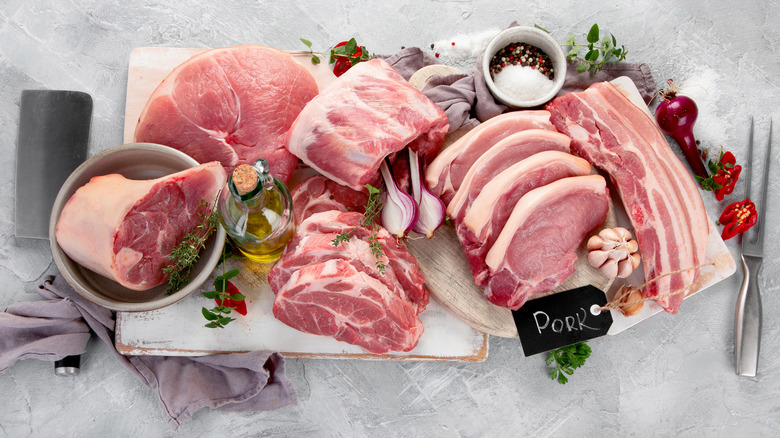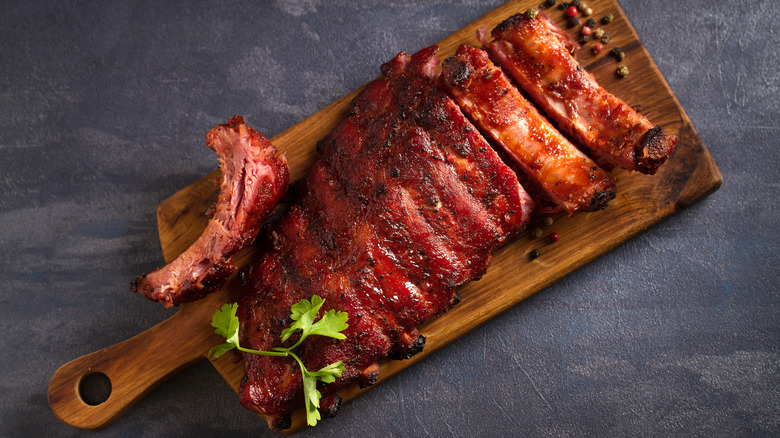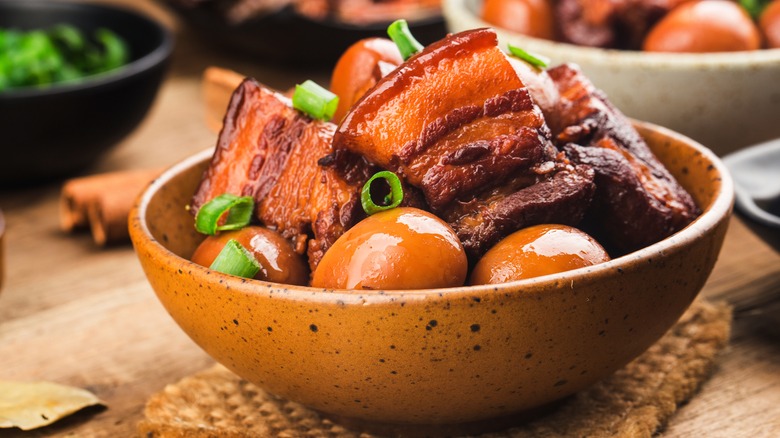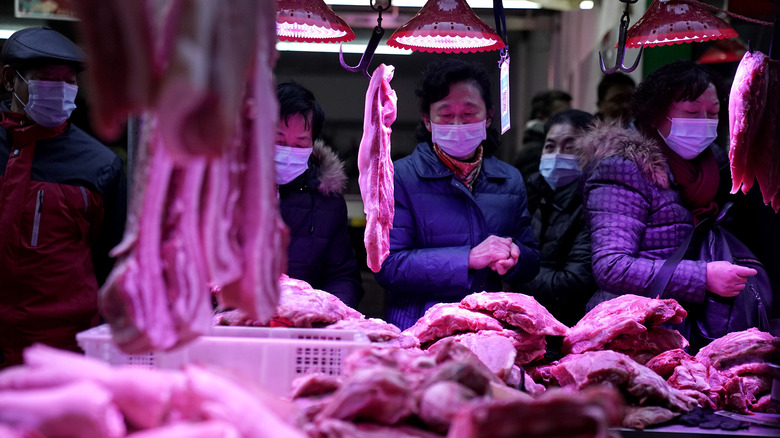Most Of The World's Pork Comes From This Country
Meat has been a part of the human diet for about 2.6 million years (via Nature). Our ancestors hunted mammoths and cut the marrow from bone for centuries. It was the key to survival, along with gathering wild-grown plants and nuts. A majority of humans around the globe still rely on meat for their protein intake and to maintain a balanced diet. One of the oldest animals ever domesticated for the intent of butchering was the pig.
The U.S. Department of Agriculture says that pork is traditionally made from pigs between six to seven months old that weigh 175 to 240 pounds and are cured into ham, bacon, and sausage or bought fresh. According to Britannica, the most sought-after pork is gray-pink, firm, and marbled with fat. Some of our favorite pork products, pork chops, pork belly, and bacon, are widely consumed in the Americas and Eastern Asia though not in places where Islam and Judaism are the predominant religions. It is super high in protein, has all of the amino acids you need, and is packed full of healthy vitamins and minerals, making it an awesome nutritional resource for those who eat meat (via Healthline).
China is the top pork producer
Pork is an enormous part of Chinese cuisine and culture, so it makes sense that China produces the most pork worldwide. In 2020, China produced 36 million metric tons of pork, followed by the European Union with 24 million metric tons, and then the U.S. with 13 million metric tons (via Beef2Live). Though the EU and the U.S. are large consumers and producers, China has a special relationship with pork.
According to The Guardian, the east Asian country doesn't consume the most meat worldwide (that crowning title goes to the U.S.A.) But China's annual pork consumption of 54 million metric tons is by far the highest in the world. BizVibe says that China consumes so much pork that even though they are the largest producer of the product, they are also the largest importer by volume and have recently been importing huge amounts from the U.S.
Chinese people rely heavily on pork in their diets. The meat product is essential to the country's traditional dishes such as Jing jiang rou si, Roast Suckling Pig, Moo Shu Pork, Tung-Po Pork, Sweet and Sour Spare Ribs, Siu yuk, Hong shao rou, Char siu, Sweet and Sour Pork, and Twice Cooked Pork (via Taste Atlas). No part of the pig is left to waste, including the livers, blood, hoofs, kidneys, intestines, and skin!
The history of pork in China
The history of pork in China extends back to the Stone Age. According to Eating China, pigs were some of the first domesticated animals in the country. They were butchered for their lard to make ham, sausages, and knuckles, and even used to strengthen pregnant women and new mothers because of all their hearty nutritional benefits. China Dialogue reports evidence of domesticated pigs existing over 9,000 years ago. They were easy to raise because they lived off of human waste (sometimes literally) and were a good source of manure for farmland. The domestic pig was not only an essential source of protein but also helped grow several dynasties' worth of crops, making them integral to the life and wellness of empires.
The pig even takes on cultural and spiritual significance in China, appearing in their zodiac calendar. World History notes that the pig symbolizes wealth and prosperity. Our ancestors were considered well-off if they raised swine. It seems that pork has always been a sign of good health, riches, and food in China, and the pork industry shows no signs of stopping.
The world of pork
Despite its own massive pork production, China imports most of the United States' annual pork exports. According to the U.S. Department of Agriculture, in 2020, China alone imported $2.3 billion worth of pork, whereas the second largest importer, Japan, bought $1.6 billion worth of the meat.
The most common pig bred for pork in North America is the Yorkshire, which is low in fat and very muscly (via Pork Check Off). There are well over a hundred different breeds of pig, and quite a variety originated in China due to its centuries of animal farming. Facts & Details says that China alone has about half the world's pigs, totaling around 450 million, with about 70% raised by small farmers.
Pork is versatile; you can marinate, roast, grill, skewer, dry rub, boil, bake, barbecue, or stir-fry it, and it is a rich and healthy source of protein for you to enjoy almost everywhere in the world, so feel free to dig into some amazing pork dishes — there is plenty to go around!



